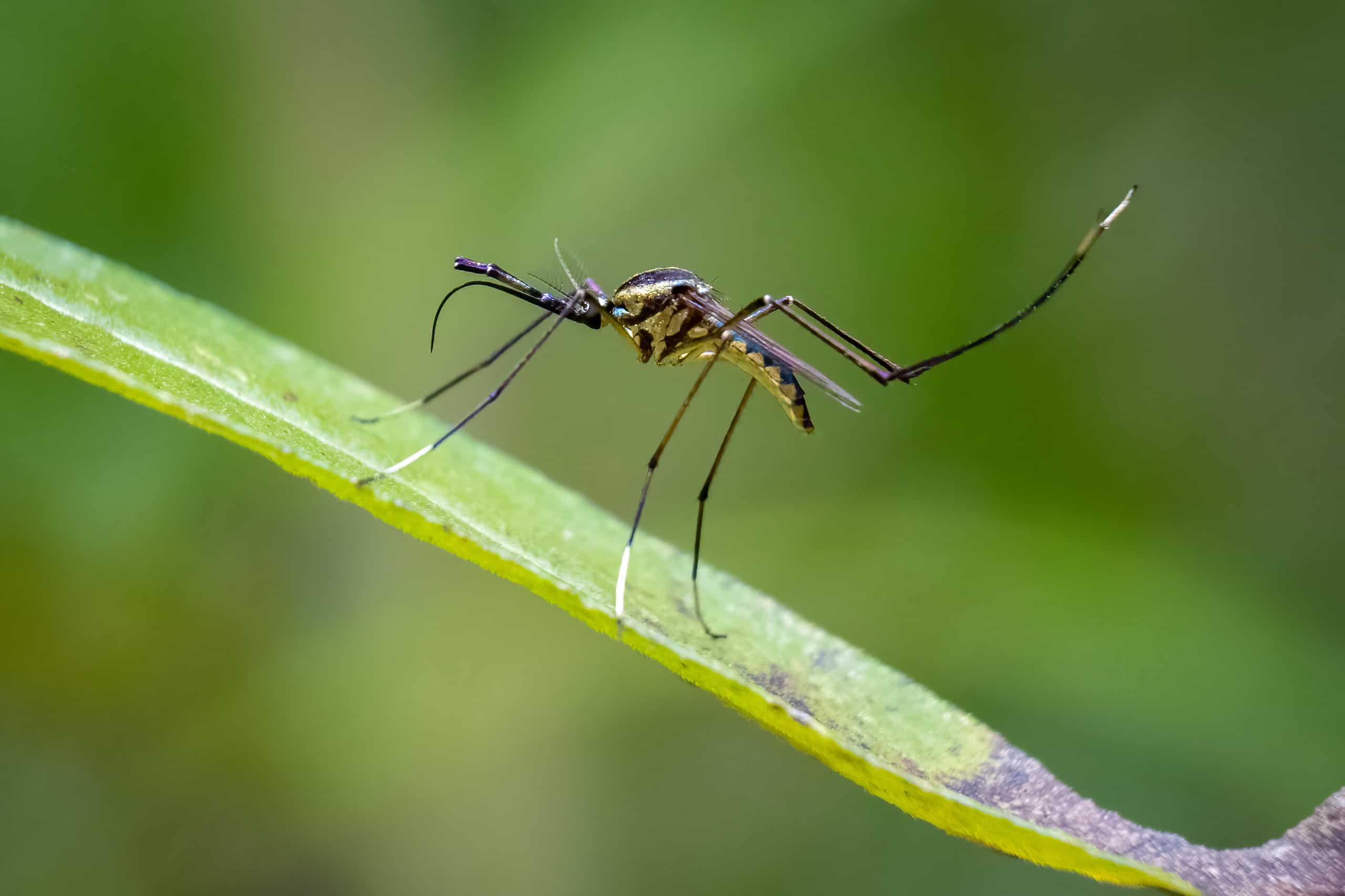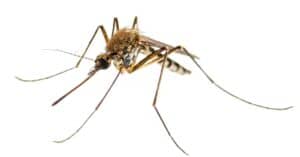Mosquitoes are some of the most common pests in human homes. They come in different species and have varied impacts. Many mosquito species are famous for spreading diseases throughout multiple states, including South Carolina.
Common Diseases Spread by Mosquitoes
- Saint Louis encephalitis virus
- West Nile
- Heartworm disease (for dogs and cats)
The mosquitoes also cause eastern equine encephalitis and la crosse encephalitis. Tracking mosquito infestation in any region is essential.
The goal is to help control mosquito growth to prevent the spread of disease and infection among humans and animals.
The Mosquito Problem
Mosquitoes are a world problem. The rate of fatality associated with mosquito bites makes them problematic.
Because the effect in the U.S. isn’t as fatal, few people consider mosquitoes dangerous in the states. Many can get away with a few bites and no consequences. Even so, this does not exempt the U.S. from mosquito-related fatalities.
Statistics from the CDC show that over 44,000 West Nile virus cases existed in the United States in 1999. There were also over 20,000 issues of spinal infections linked to mosquitoes in the country. These insects are also responsible for over 1,900 cases of U.S. human mortality. Because mosquito-related diseases can lead to fatalities in the U.S., it is vital to control the population.
Types of Mosquitoes that Can Cause Fatalities
South Carolina has over 61 mosquito species. Note that only specific mosquitoes carry viruses. Besides that, only two types of mosquitoes tend to carry the worst viruses.
In America, only Aedes aegypti and Aedes albopictus qualify as dangerous. Unfortunately, both mosquito species have some distribution in South Carolina.
The mosquitoes are vectors for yellow fever, west Nile, and eastern equine encephalitis. They also cause zika, dengue, and chikungunya diseases.
1. Aedes albopictus (Asian Tiger Mosquito)
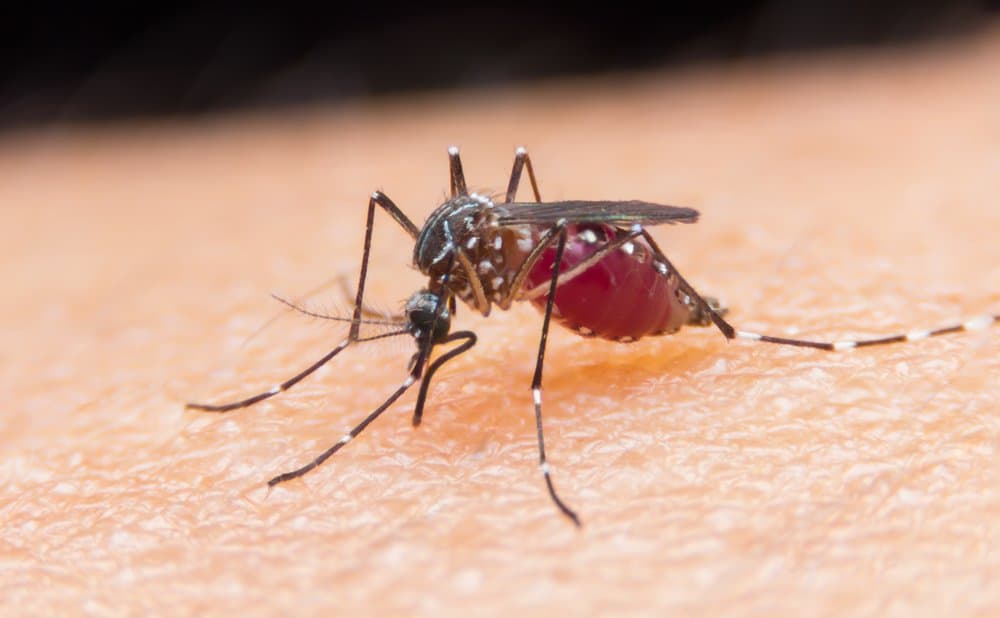
The
tiger
mosquito originated in Asian and eventually made its way into the U.S.
©AUUSanAKUL/Shutterstock.com
The Asian tiger mosquito is among the most vicious South Carolina mosquito species. They start invading at the beginning of fall.
Areas most affected by these mosquitoes include the Palmetto State. The tiger mosquito originated in Asian and eventually made its way into the U.S. It remains the most prevalent biting species of mosquito in South Carolina. The mosquito species is common around Columbia, Lexington, and Midland.
These mosquitoes have a unique physical appearance. The body has a tiger-stripe pattern that is easy to identify. The white strip runs from the insect’s middle to its head. You can identify it by the single stripe running down the insect’s middle. The white band around its legs also makes it easy to identify.
They are a small species, growing only a quarter inch long.
2. Aedes aegypti (Yellow Fever Mosquito)
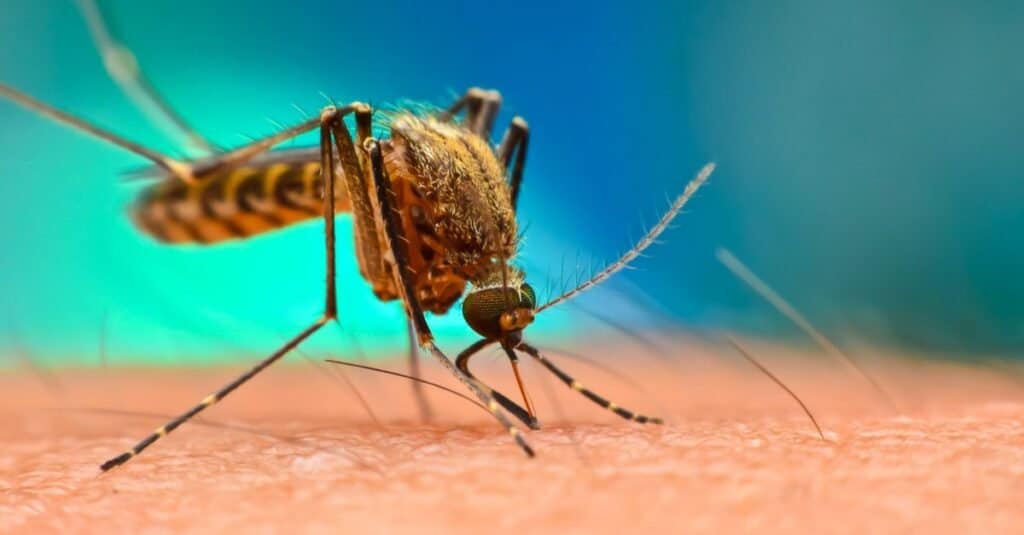
The yellow fever mosquito is mainly known for the transmission of Zika, dengue, malaria, and yellow fever.
©Digital Images Studio/Shutterstock.com
Originally from Africa, this mosquito species was transported to America by European explorers. It is mainly known for the transmission of:
- Zika
- Dengue fever
- Mayaro
- Chikungunya
- Yellow fever
They also have a unique appearance. They have silvery-white scale bands on the legs and a U-shaped abdomen with a lyre-like thorax.
3. Anopheles quadrimaculatus (Quads)
Mostly found in southern rice farmlands. It transmits Malaria, heartworms, and west Nile virus.
4. Culex quinquefasciatus (Southern House Mosquito)

This species prefers indoor spaces, especially at night.
©iStock.com/Arnav Ray
This is a very common mosquito in the U.S. The species prefers indoor spaces, especially at night. They are medium-sized, brown with white stripes and golden scales. It is an opportunistic night feeder that mainly targets birds. However, it also feeds on mammals and humans.
They can transmit the following:
- Avian malaria
- Lymphatic filariasis
- St. Louis encephalitis
- Zika
- Western equine encephalitis
- West Nile
5. Culiseta inornata (Winter Mosquito)
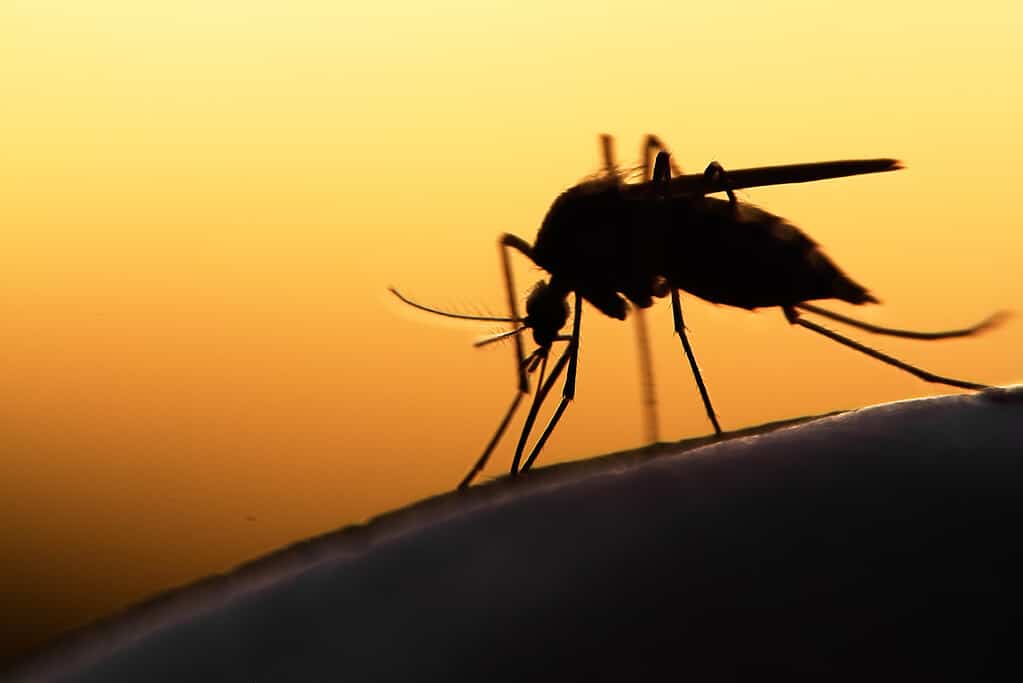
The winter mosquito is larger than most other species, measuring half an inch in size.
©mycteria/Shutterstock.com
This mosquito species is active in winter and colder months. They are brown and have speckles with white scales. However, they lack bands.
The winter mosquito is also larger than most other species, measuring half an inch in size. They are most bothersome to livestock, especially when in large numbers. They may carry health-threatening diseases.
Sickness Related to Mosquitoes
Mosquitoes can potentially cause a variety of diseases. The disease caused depends on the mosquito species.
Unfortunately, detecting the specific virus caused by the mosquito is not always easy due to difficult diagnosis. Symptoms are closely related to the common flu.
Affected victims tend to have diarrhea, nausea, body aches, rash, fever, and headaches. The disease may remain undetected unless hospitalization happens.
What’s more, symptoms range from undetectable to seriously life-threatening. For example, a mosquito bite can lead to childbirth deformities in the case of the zika virus.
Biological Factors Supporting Mosquito Spread
Mosquitoes thrive in specific conditions. They generally need a warm, moist environment to thrive and re-populate. Unfortunately, South Carolina offers adequate grounds for both. The heavy rainfalls and flash floods contribute to the area’s conducive weather.
Usually, subtropical and tropical storms make a huge difference. These weather events make conditions perfect for mosquitoes to increase in number. The warm climate of South Carolina runs from March to October. But the mosquito peak season is during summer months. This is when mosquito activity is on the rise. Seasonal temperature and rainfall amounts affect the level of insect activity.
As a homeowner in South Carolina, your goal should always be to minimize moisture. Mosquito populations will reduce naturally when water sources are controlled.
Breeding Needs
Mosquitoes need only an inch of stagnant water to breed.
How to Control Mosquitoes Breeding
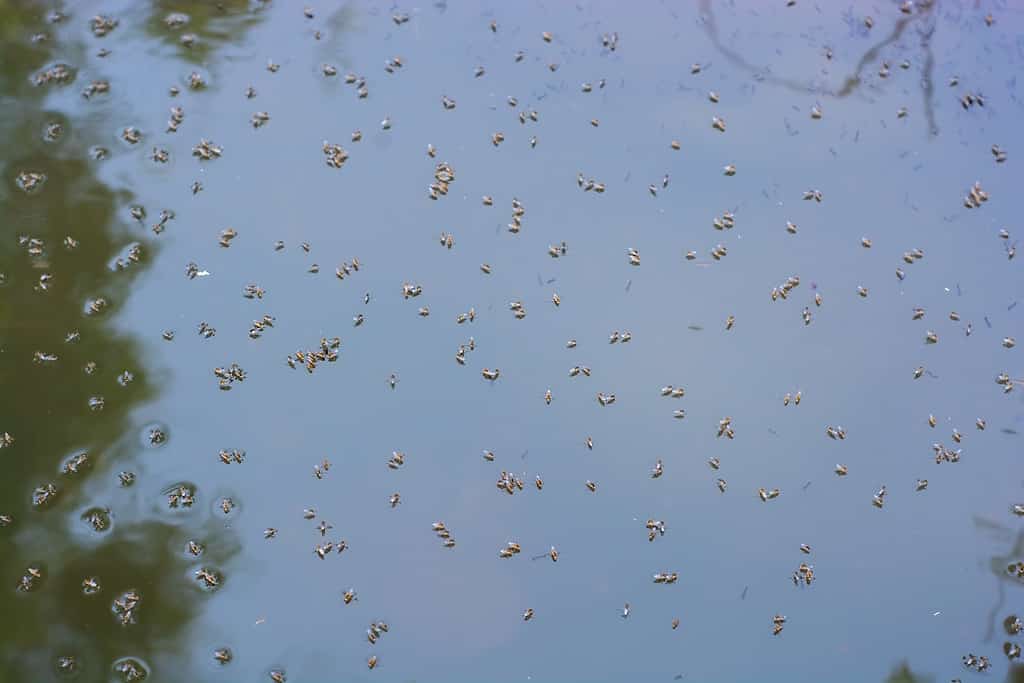
Eliminate stagnant water to prevent and control mosquito breeding.
©Hussain Warraich/Shutterstock.com
Discourage mosquito breeding in South Carolina by doing the following:
- Remove water-holding containers from your backyard in case of rain.
- Drain collected rainwater from outdoor containers that cannot be stored indoors.
- Change the water regularly in containers like birth baths. This will discourage mosquito eggs or larvae from maturing into adult mosquitoes.
- Cover containers that you cannot remove or alter. Use slanted tarps to direct the water to the ground.
- Trim bushes and overgrown tree branches. This encourages faster drying of the ground underneath.
- Rake up debris and leaves.
- Check on the gutters and downspouts. Ensure the water flows downwards away from the foundation walls. It is best to have guarded gutters to prevent water clogs.
Combining these treatment routines is the best way to control mosquito infestation.
Next, you must invest in seasonal mosquito treatment from reliable professionals. These can help reduce and eliminate mosquitoes.
The treatments involve applying active ingredients that are strong enough to deal with the mosquitoes. The treatments turn bushes and branches into massive mosquito traps.
The current population will die, and it will take a while before a new infestation develops. This is because mosquitoes rarely move extensive distances. Mosquitos move a few yards at a time, which means that when eliminated, it takes a while before they are replaced.
Investing in seasonal mosquito treatment is always recommended. While mosquitoes are not usually killers in the U.S., vector-carrying mosquitoes can cause severe diseases.
Other Insects Set to Emerge in South Carolina
Besides mosquitos, South Carolina residents should look out for other insects. Several insect species are bound to invade the area. These include:
Asian Long-Horned Beetle
This is an invasive insect species that threatens trees. The insects chew at the bark until it kills the tree.
Residents are advised to report the sighting of these insects. Based on the USDA, South Carolina is one of four states fighting the invasion of the long-horned beetle.
These destructive beetles are identifiable by their size and color. They are 1-2 inches long. They have a black body with white-striped antennae. You can further identify these insects by their six legs and white spots.
Unfortunately, it is not always easy to spot adult long-horned beetles. The researchers at Clemson University say they can only be seen from May to August. Residents ought to scout for tree damage signs, focusing on host trees, where you’ll probably find eggs.
Trap the beetle in a jar if you can. These insects are harmless to pets and humans, despite being aggressive to trees.
German Cockroaches
These insects are common in South Carolina. Though they are not native to America, they are believed to have been introduced in the Seventeenth17th century from Africa.
However, German cockroaches are the most invasive roach in South Carolina homes. Their tiny size makes them fit in any small space. They also tend to breed excessively and can take over a home quickly.
Unfortunately, they pose great danger. Their droppings, decaying bodies, and saliva cause allergies. This may worsen asthma attacks in kids.
Fire Ants
These have to be the most dangerous ants in South Carolina. They exist in colonies and form ant hills around homes.
These ants only attack humans by stinging when they feel threatened, but they have a painful sting. This could trigger severe symptoms in allergic individuals. Usually, the sting leaves blisters and a burning itch.
The Carpenter Ant
This is one of South Carolina’s most common large-sized ants. It measures about 13mm long and can be either red, black, or yellow.
They mostly come out in spring but significantly drop in number during the fall. While these insects are not harmful to humans and pets, they can jeopardize the stability of your wooden foundations. They mostly consume rotten wood.
Japanese Beetle
This insect is native to Japan. It was first introduced to America over a century ago. Its distinct bronze body and metallic green wings make it difficult to miss. Though beautiful, these insects are destructive. They feed on leaves, fruits, and the flowers of over 300 plant species.
Emerald Ash Borer
This metallic green insect was first discovered in the U.S in 2002 and made its way to South Carolina in 2017. It preys on the ash tree and is a major issue in over 30 states. It is suspected to have originated from Asia.
Kudzu Bug
This insect is new to South Carolina. It was first spotted in 2009 and is suspected to have come from Asia.
It feeds on Kudzu, an invasive species. Unfortunately, it also feeds on soybeans and crops. Their foul-smelling secretions are staining and can also cause blistering when handled.
Brown Marmorated Stink Bug
This newcomer was first spotted in South Carolina in 2011. They are a mixture of brown and gray, with black antennas. These insects are a problem as they feed on various plants and crops and invade homes in winter.
Thank you for reading! Have some feedback for us? Contact the AZ Animals editorial team.

